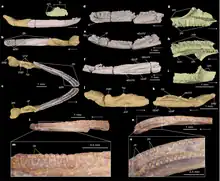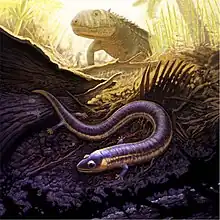| Funcusvermis Temporal range: Late Triassic, Norian | |
|---|---|
 | |
| Holotype and paratype specimens | |
 | |
| Life restoration (foreground) with Acaenasuchus (background) | |
| Scientific classification | |
| Domain: | Eukaryota |
| Kingdom: | Animalia |
| Phylum: | Chordata |
| Class: | Amphibia |
| Order: | Gymnophiona |
| Genus: | †Funcusvermis Kligman et al., 2023 |
| Species: | †F. gilmorei |
| Binomial name | |
| †Funcusvermis gilmorei Kligman et al., 2023 | |
Funcusvermis is an extinct genus of stem-caecilian from the Late Triassic of Arizona. It is based on a large sample of jaws and other skull and postcranial fragments, discovered in an approximately 220 million years old layer of rock in the Blue Mesa Member of the Chinle Formation at Petrified Forest National Park. There is a single species, called Funcusvermis gilmorei.[1][2]
The identity of Funcusvermis as a gymnophionan amphibian is supported by a range of traits, including a long additional tooth row in the jaw, a fused maxillopalatine bone in the skull, and a modified jaw with a pseudodentary and pseudoangular. Small femora (thigh bones) indicate that legs were still present in Funcusvermis, despite its modern relatives being completely legless. Funcusvermis is the oldest known gymnophionan, and has the largest known sample of fossils referred to the group.[1] Previously, both records were held by Eocaecilia micropodia, an amphibian from the Early Jurassic Kayenta Formation of Arizona.[3]
The discovery of Funcusvermis provides a strong link between caecilians and other lissamphibians (frogs and salamanders), as well as extinct dissorophoid temnospondyls such as Gerobatrachus. It supports the consensus hypothesis for lissamphibian evolution, with Lissamphibia as a monophyletic group with a single common ancestor among the dissorophoids. Consequently, the anatomy of Funcusvermis helps to compare and contrast alternative hypotheses for lissamphibian origins.[1] For example, a 2017 study proposed that caecilians were related to Chinlestegophis, a stereospondyl from strata of the Chinle Formation in Colorado.[4] This study was scrutinized and its conclusions were rejected by the description of Funcusvermis.[1]
The genus name translates to "funky worm", in reference to the funk song of the same name by the Ohio Players.[1][2] The species name honors collections manager Ned Gilmore of the Academy of Natural Sciences of Drexel University in Philadelphia, Pennsylvania, United States.[1]
References
- 1 2 3 4 5 6 Kligman, Ben T.; Gee, Bryan M.; Marsh, Adam D.; et al. (25 January 2023). "Triassic stem caecilian supports dissorophoid origin of living amphibians". Nature. 614 (7946): 102–107. doi:10.1038/s41586-022-05646-5. hdl:10919/113568. ISSN 1476-4687. PMC 9892002. PMID 36697827. S2CID 256272986.
- 1 2 Mackay, Steven (25 January 2023). "New geosciences study shows Triassic fossils that reveal origins of living amphibians". Virginia Tech. Retrieved 27 January 2023 – via ScienceDaily.
- ↑ Jenkins, Farish A.; Walsh, Denis M.; Carroll, Robert L. (1 August 2007). "Anatomy of Eocaecilia Micropodia, A Limbed Caecilian of the Early Jurassic". Bulletin of the Museum of Comparative Zoology. 158 (6): 285–365. doi:10.3099/0027-4100(2007)158[285:AOEMAL]2.0.CO;2. S2CID 86379456.
- ↑ Pardo, Jason D.; Small, Bryan J.; Huttenlocker, Adam K. (2017-07-03). "Stem caecilian from the Triassic of Colorado sheds light on the origins of Lissamphibia". Proceedings of the National Academy of Sciences. 114 (27): E5389–E5395. Bibcode:2017PNAS..114E5389P. doi:10.1073/pnas.1706752114. ISSN 0027-8424. PMC 5502650. PMID 28630337.